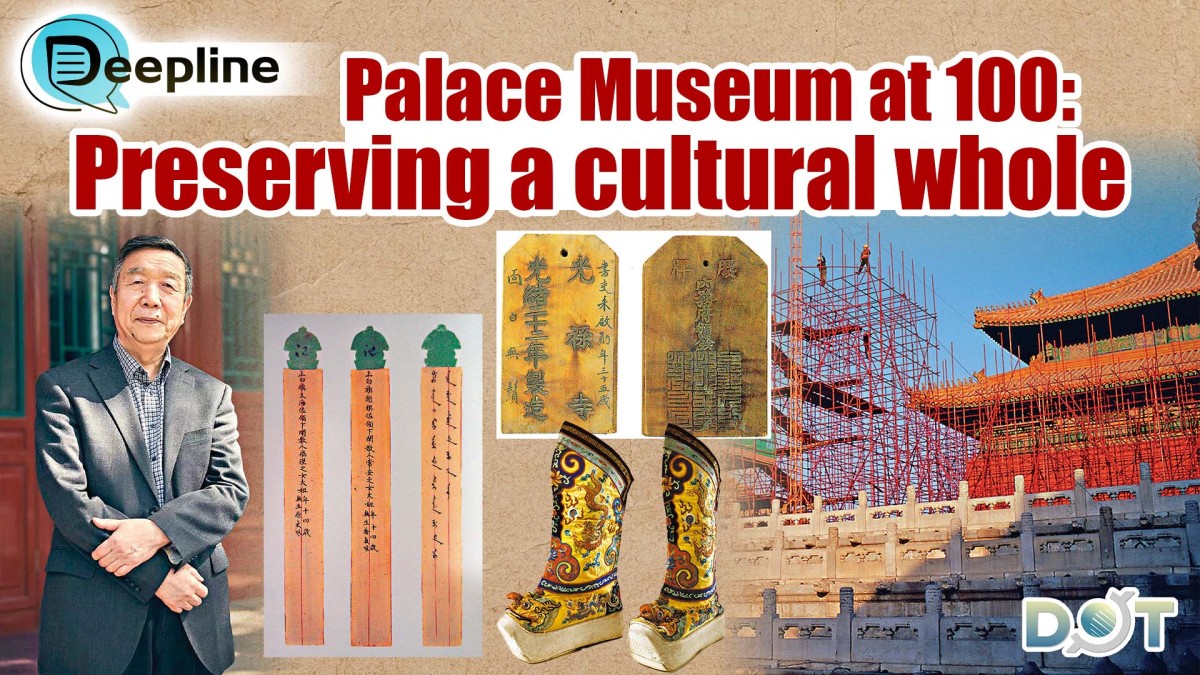
This year marks the centenary of the Palace Museum. As a representative symbol of Chinese civilization, the Palace Museum carries the profound heritage of thousands of years of history and culture. Looking back at history, the spatial dimensions of the Forbidden City are measurable, but its cultural significance is immeasurable.
"Some say the Palace Museum is the Forbidden City; others say it is a museum. But I believe the museum, ancient architecture, cultural relics, and archival documents are not fragmented; the Palace Museum is a cultural whole," said Zheng Xinmiao, the former director of the Palace Museum in Beijing who served for nearly a decade and the first proposer of "Palace Museum Studies," in an exclusive interview with Wen Wei Po, sharing his understanding of the Museum.
In 2003, Zheng proposed the concept of "Palace Museum Studies," advocating for a holistic cultural perspective to understand the intrinsic connections between the Forbidden City, its cultural relics, and the Palace Museum. This approach aims to overcome the "fragmentation" in academic research and value recognition of the Palace Museum, providing an academic home for the scattered Qing imperial collections worldwide and offering a unique and precious resource for studying and understanding Chinese history and culture. Over the past two decades, the connotation and extension of Palace Museum Studies have continuously expanded. With his academic accumulation and management practice, Zheng has systematically organized the objects, events, and people of the Palace Museum, bridging history and reality.
From "collection" to "scientific management"
During Zheng's nearly decade-long tenure as director, he promoted a seven-year project to inventory cultural relics, resulting in a comprehensive and scientific count of over 1.8 million cultural relics in the Palace Museum. This was the first time since the museum's establishment that a complete and accurate number of the collection had been determined. One significant achievement was the thorough inventory of historical court artifacts. Many previously overlooked items, such as ceremonial headdresses, shoes and boots, red and green head tags, and waist tokens, were reclassified as cultural relics, achieving a leap from "collection" to "scientific management."
Regarding this, he stated that the inventory of Palace Museum relics benefited from many favorable factors, among which Palace Museum Studies played an important role as a guiding ideology and concept. In the philosophy and practice of "Complete Palace" conservation, the inventory of cultural relics not only accomplished the task of taking stock and ensuring accounts matched physical items but also integrated with efforts to enhance scientific and safety management of the relics, thereby improving the overall management level of cultural relics.
The Palace Museum is a comprehensive history in itself. Zheng emphasized that Palace Museum Studies treat the museum's collection of cultural relics, ancient architecture, and historical court sites as an interconnected whole. This approach breaks down disciplinary boundaries, evaluates and understands the cultural value and connotations of research subjects from a holistic cultural perspective, and prevents the "fragmentation" of cultural relic research.
The holistic research method of Palace Museum Studies also requires researchers to courageously transcend traditions and broaden new research paradigms. For example, in 2014 and 2015, over 1,000 pieces of damaged jade artifacts and raw jade materials were excavated twice in the South Warehouse area of the Palace Museum. The team led by Yang Jing, a research fellow at the Palace Museum's Archaeology Department, applied archaeological methods to study these damaged jade artifacts and materials, complementing traditional jade research methods.
Furthermore, Palace Museum Studies serve as the guiding ideology for the "Complete Palace" conservation. The "Complete Palace" encompasses the integrity of the layout, ancient architecture, and cultural relic collections, which is determined by the holistic value of the Palace Museum and reflects the responsibility of its staff in safeguarding cultural heritage.
Zheng noted that this concept has played a significant role in the conservation of the Palace Museum over the years. Since the early 21st century, the Palace Museum has undergone its largest-scale restoration project in a century, guided by the principle of "complete conservation and comprehensive restoration," with the overarching principle of "not altering the original state of the cultural relics."
For instance, the restoration of the eastern and western side halls of the Hall of Preserving Harmony restored their external corridor layout, and the external fittings of the eastern and western side halls of the Hall of Heavenly Purity replaced modern glass windows with the original removable windows.
Bringing Palace Museum to the world
In recent years, China's overseas loss of cultural relics has attracted widespread attention, with related investigations and recovery efforts continuously advancing. The vast majority of these relics are court artifacts, deeply connected to the Palace Museum. Zheng said that the Ming and Qing courts centered around the Forbidden City but also included the Old Summer Palace, Summer Palace, Shenyang Imperial Palace, and Chengde Mountain Resort, with all their cultural relics belonging to the Qing court collection.
Since modern times, the Qing court's cultural relic collections have been repeatedly plundered or destroyed, with over a million relics lost. After the founding of the People's Republic of China, in addition to the transfer of Ming and Qing archives and many ancient books and rare editions, 84,000 Palace Museum relics were allocated to other institutions to distribute and utilize national cultural resources.
Palace Museum Studies, with the core concept of "the Palace Museum as a cultural whole," provides an academic home for these scattered relics. According to Zheng, scattered relics maintain cultural connections with the Palace Museum, and only by incorporating them into holistic research can their connotations be deeply explored and the complete value of the Palace Museum be demonstrated. Palace Museum Studies advocates that "the Palace Museum is in Beijing, but Palace Museum Studies are in China and the world," calling for collaboration within the domestic and international academic communities to promote it as an internationally prominent field of study.
"The palaces represent the pinnacle of China's two to three thousand years of palace architectural history. Their layout, specifications, colors, orientations, etc., all contain traditional cultural knowledge, making them the sole instance and highest paradigm of Chinese palace architecture. The Palace Museum's collection represents the essence of major categories of Chinese culture and art, with some items unique to the court, such as pearl bonsai and ivory cooling mats, reflecting the wisdom of ancestors and carrying 5,000 years of historical culture."
"The research outcomes of Palace Museum Studies are not only reflected in papers and works but also in the cultural dissemination of the Palace Museum," Zheng said. This is mainly reflected in: organizing exhibitions well and telling the stories of the Palace Museum's cultural relics; managing the Palace Museum website well, providing digital resources and services to the public in various forms, with the multilingual website upgraded to five languages: English, French, Russian, Japanese, and Spanish; skillfully using digital new media technologies, accurately grasping the interests and attention characteristics of young people, and promoting the profound Chinese civilization in meaningful and interesting forms.
Resonance across the strait
The collections of the Palace Museums on both sides of the Taiwan Strait have always been a focus of public attention.
Zheng mentioned that the collections of the Beijing and Taipei Palace Museums share the same roots and complement each other. He recalled that the separation of the two Palace Museums originated from the southward relocation of cultural relics during the War of Resistance against Japan. The Taipei Palace Museum houses over 2,900 crates of these relocated relics, including many treasures, while the Beijing Palace Museum, as the original repository of Qing court relics, possesses a more comprehensive and richer collection system. These relics together form an inseparable whole of cultural heritage.
Although there was once a long period of frozen relations, academic exchanges between the two Palace Museums never ceased. In 2009, the directors of both museums achieved a historic exchange of visits and jointly held the "Harmony and Integrity Emperor Yongzheng and His Times" exhibition in Taipei, with the Beijing Palace Museum lending 37 artifacts.
Subsequently, in two important exhibitions in 2011, the Beijing Palace Museum lent 4 and 14 artifacts, respectively. In response to external questions about whether this was a "loss," Zheng replied, "We believe this is the cultural property of the Chinese nation, so there is no question of loss. We firmly believe that the relics in the Taipei Palace Museum will eventually be exhibited in the Forbidden City."
"The essence of Palace Museum Studies is to view the Palace Museum as a cultural whole."The collections of the two Palace Museums are vast in quantity, diverse in types, and intricately interconnected. Only by examining them within the overall cultural context can their historical value be deeply explored and cultural exchange promoted. He illustrated this with an example: the bronze ware collections of the two Palace Museums share the same origin, resulting in a complete chronological sequence and comprehensive range of types, with sets of artifacts divided between the two museums.
Since the "ice-breaking" in 2009, cooperation between the two sides in personnel and academic fields has gradually developed. Zheng believes that with the digitization and opening of resources, future exchanges between the two Palace Museums will inevitably deepen. He is convinced that the two Palace Museums are connected by shared roots, and the deeper the academic research, the broader their connections will become.
(Source: Wen Wei Po; Journalist: Sun Zhi, Jiang Xinxian; English Editor: Darius)
Related News:
100 Ways To Drool | Afternoon tea in the Forbidden City
The Palace Museum in a Minute EP3|The Caisson Ceiling【The Palace Museum Centennial】




















Comment